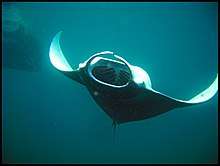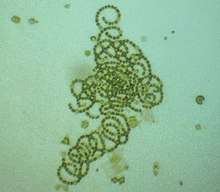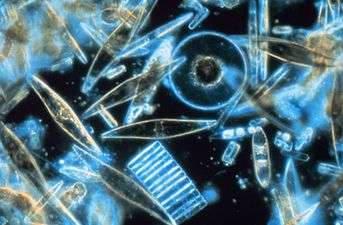Planktivore
A planktivore is an aquatic organism that feeds on planktonic food, including zooplankton and phytoplankton.[1][2]

Forms of plankton


Phytoplankton are usually photosynthetic one-celled organisms. These organisms are usually found near the surface of the water due to their need for light energy for their photosynthetic processes. Phytoplankton provide most of the oxygen that is in the water and provide a large amount of food for other organisms in the water column.
Zooplankton, in contrast, are heterotrophic plankton, animals which ingest nutrients rather than producing it via chemical reactions. Some taxa are planktonic for only part of their life cycle.
Forms of planktivory
Planktivores ingest one or both types of plankton. Titanichthys was the first massive vertebrate pelagic planktivore, with a lifestyle similar to that of the modern basking, whale, or megamouth sharks.[3]
Most fish are planktivores during part or all of their life cycles, especially when they are larvae.[4] There are obligate planktivores, which feed only on plankton, and facultative planktivores, which take plankton when available but eat other types of food as well.[4] The gizzard shad (Dorosoma cepedianum), for example, has a voracious appetite for various forms of plankton across its life cycle. It is an obligate planktivore when it is a juvenile, in part due to its very small mouth size. As it grows it becomes an omnivore, taking phytoplankton, zooplankton, and larger pieces of nutritious detritus. Adult gizzard shad consume large volumes of zooplankton until it becomes scarce, then turn to organic debris for food.[5]
Planktivores obtain food in two ways. Particulate feeders eat planktonic items selectively. Filter feeders process volumes of water and strain food items en masse.[4] "Tow-net" filter feeders swim rapidly with mouths open to filter the water, and pumping filter feeders suck in water via pumping actions. The latter includes stationary animals, such as corals.[4] Another form of filter feeding is a "gulping" behavior, in which the animal takes boluses of water; the alewife (Alosa pseudoharengus) feeds in this manner.[4]
Planktivore ecology
Plankton are among the lower trophic levels in food chains. Planktivores affect the food chain by altering the populations of plankton in various ways, a process known as the trophic cascade. The gizzard shad, again, plays this role. It consumes phytoplankton when it is small, zooplankton when it is larger, and other foods when it eliminates the zooplankton in the area. It incidentally controls the populations of other fish that depend on zooplankton, such as bluegill (Lepomis macrochiris).[6]
See also
- Carnivore – Organism that eats mostly or exclusively animal tissue
- Consumer–resource interactions
- Filter feeder
- List of feeding behaviours
- Productivity (ecology) – The rate of generation of biomass in an ecosystem
References
- Rudstam, L. G.; Lathrop, R. C.; Carpenter, S. R. (1993). "The rise and fall of a dominant planktivore: Direct and indirect effects on zooplankton". Ecology. 74 (2): 303–319. doi:10.2307/1939294. JSTOR 1939294. PDF file
- Brooks, L. Jog. (1968). "The effects of prey size selection by lake planktivores". Syst Biol. 17 (3): 273–291. doi:10.1093/sysbio/17.3.273.
- Boyle, L. Jog. (2017). "New information on Titanichthys (Placodermi, Arthrodira) from the Cleveland Shale (Upper Devonian) of Ohio, USA". Journal of Paleontology: 1–19. doi:10.1017/jpa.2016.136.
- Lazzaro, X. (1987). A review of planktivorous fishes: Their evolution, feeding behaviours, selectivities, and impacts. Hydrobiologia, 146, 97-167.
- Stein, Roy A., et al. (1995). Food-web regulation by a planktivore: exploring the generality of the trophic cascade hypothesis. Canadian Journal of Fisheries and Aquatic Sciences 52(11): 2518-26.
- DeVries, D. R., and R. A. Stein. (1992). Complex interactions between fish and zooplankton: quantifying the role of an open-water planktivore. Canadian Journal of Fisheries and Aquatic Sciences 49(6): 1216-27.

